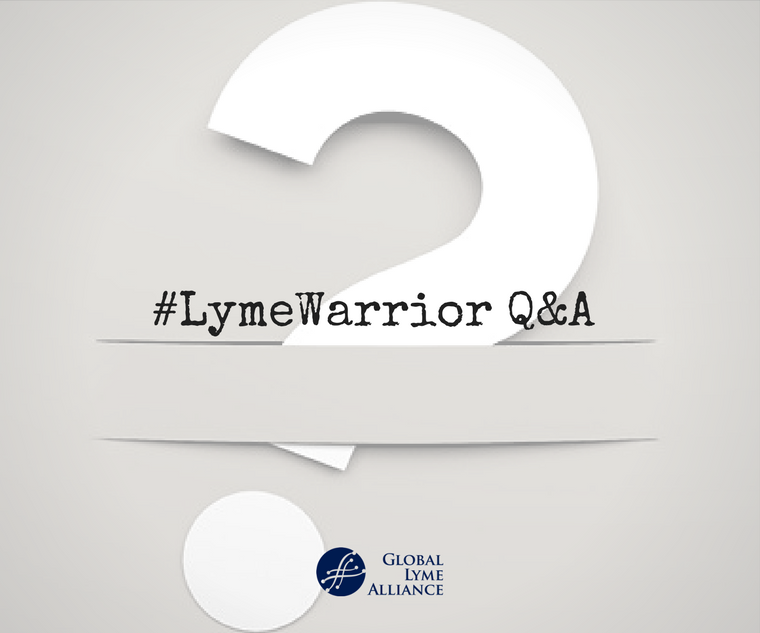
by Jennifer Crystal
EVERY COUPLE MONTHS, LYME WARRIOR JENNIFER CRYSTAL DEVOTES A COLUMN TO ANSWERING YOUR QUESTIONS. HERE ARE HER ANSWERS TO QUESTIONS SHE IS FREQUENTLY ASKED.
Do you have a question for Jennifer? Email her at jennifercrystalwriter@gmail.com.
Since blood tests aren’t 100%, how can you be definitive you have Lyme?
Lyme disease is difficult to diagnose for exactly the reason you describe: there is not yet a reliable test. This is because current tests look for antibodies for Lyme in your blood, rather than for the bacteria itself. Western Blot tests from labs like Igenex are more sensitive, looking for a larger spectrum of bands than the standard CDC test, but Western Blot tests are still not fool proof. The best way to know if you have Lyme is to get a clinical diagnosis by a Lyme-Literate Medical Doctor (LLMD), who will look at your complete medical history and symptoms.
In our society we tend to think tests are the only way to diagnose disease, but it’s important to remember that doctors diagnoses lots of illnesses—like colds, sinus infections, and the flu—without tests. We trust their expertise in those areas and we have to do the same with Lyme, as long as the doctor is Lyme literate. My CDC tests did come back positive—for Lyme and co-infections babesia, and ehrlichia—but it was my doctor’s clinical expertise that made me sure of my diagnosis.
The other way you can tell you if really have Lyme is based on how you react to treatment. If you experience a Jarisch-Herxheimer reaction, when you feel worse before you feel better because the antibiotics are killing the Lyme bacteria faster than your body can eliminate them, then you know the spirochetes really are there.
The CDC states that laboratory tests are “helpful” in diagnosing Lyme, but not definitive. The best thing you can do is find an LLMD whom you trust. Had I not found an LLMD to diagnose and treated me accurately, I would still be bedridden.
I had Lyme years ago, and now I think I have a new infection. If my blood tests come back positive, how will I know if that’s an old or new infection?
Blood tests look for two different types of antibodies: Immunoglobulin G (IgG) and Immunoglobulin M (IgM). IgG are longer-term antibodies that are produced later and stay in your system after you’ve had an infection. If you had chicken pox as a child, you still have IgG antibodies for chicken pox. IgM antibodies are produced more immediately, and represent a new, acute infection. Since you had Lyme before, you will still have IgG antibodies for it. If you show IgM antibodies, however, that’s a sign of a new infection. Your LLMD will be able to differentiate between the two.
That said, after a tick bite, it can take your body awhile to build up enough antibodies to produce a positive blood test. For that reason and for the reasons outlined in question 1, it’s important for you to see an LLMD who can evaluate whether your symptoms are a sign of new or recurring infection, and also whether you have new or recurring co-infections.
What helps most with low blood sugar?
Lyme disease can impair adrenal function, which in turn can cause reactive hypoglycemia (blood sugar swings). This is also a common symptom of babesia. Hypoglycemia was one of the first symptoms I experienced. Shortly after finding a strange red rash on my forearm, I fainted one day due to low blood sugar. This had never happened to me before. I continued to have low blood reactions at inopportune moments for years. Though doctors confirmed I was hypoglycemic, they never looked into why I’d suddenly developed it. Had they, my tick borne illnesses might have been diagnosed much earlier.
Now that I have an accurate diagnosis and have been treated, my hypoglycemia is better, but not gone. There are a few things that have helped me the most. The first is sticking to a gluten-free, sugar-free diet. This has helped my blood sugar stay more stable, with the added bonus of keeping intestinal yeast overgrowth at bay.
I try to limit carbohydrates like bread and pastries (even the gluten-free, sugar-free kind, because they still cause a quick rise and then drop in blood sugar) and instead eat whole grains like rice and quinoa. I’ve found that it helps to have protein and complex carbohydrates at every meal and snack. The protein gives me sustained energy; without it, my blood sugar will crash an hour or two after the meal. The carbohydrates fill me up and raise my blood sugar to a healthy level; without them, I feel nauseous and lightheaded.
I know when my co-infection babesia is flaring up because in addition to air hunger (feeling like my body isn’t getting enough oxygen), exertion fatigue and headaches, my blood sugar crashes more frequently, and I have bouts of lightheadedness. I’ve found that during these times it helps to eat meals rich in iron. A steak and a big bowl of spinach can make a big difference. Cinnamon is also a great blood sugar stabilizer. Try sprinkling some on steel cut oats with protein powder for breakfast.
Finally, I recommend always having snacks on hand. You never know when you’re going to get stuck in traffic and your blood sugar will drop. I always carry a granola bar and a box of raisins in my purse, and I keep a juice box (made with 100% juice and no added sweeteners) on my nightstand, for those pesky middle of the night crashes.
 Opinions expressed by contributors are their own.
Opinions expressed by contributors are their own.
Jennifer Crystal is a writer and educator in Boston. She is working on a memoir about her journey with chronic tick-borne illness. Contact her atjennifercrystalwriter@gmail.com

GLA
Admin at GLA
